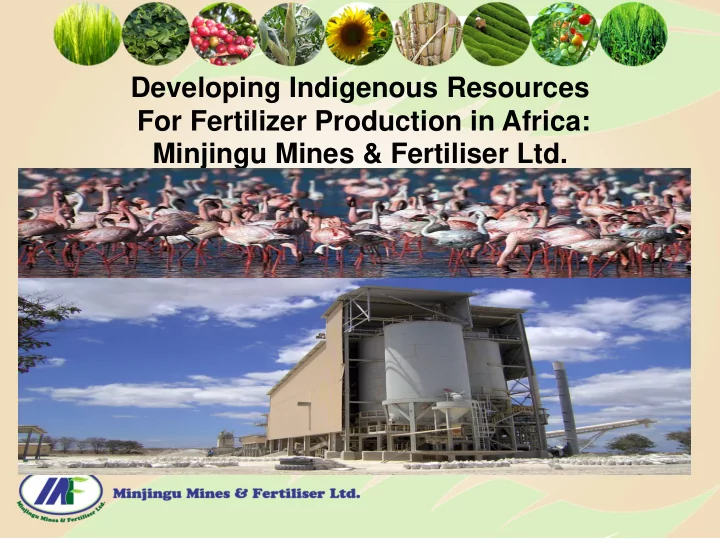

Developing Indigenous Resources For Fertilizer Production in Africa: Minjingu Mines & Fertiliser Ltd.
Presentation outline i. Historical Background ii. Mining and beneficiation process iii.Minjingu Rock Phosphate and its effectiveness iv. Development of Minjingu Mazao, trials, partnerships v. Advantages of using Minjingu Mazao and the distribution network in Tanzania vi.Challenges of placing a new product in the market vii.Results from selected trials. viii.conclusion
Historical background 2011 2008 Blending Granulation Govt Privatized MIPCO in 2001 and renamed TFC closed Minjingu Mines & Fertilizers down in 1990 ( MIPCO) Discovered 1980s 1956.
Mining & Beneficiation 22% P 2 O 5 Benefi- Granu- Open cast Blending ciation lation Mining 30% P 2 O 5 Market Market Market
Blending
Minjingu Hyper Phosphate Composition Mainly ; P 2 O 5 – 30% CaO - 38
Effectiveness of MRP Minjingu phosphate is one of the most reactive rocks in the world. Most of the Sub Saharan soils are low in P and highly acidic, hence MRP works well. Research results shows that within the 15 days of contact with soil, 50 % of Phosphorous is solubilized and made plant available, and equilibrium with soil P is attained within the 50 days. MRP has now been granulated to make it user – friendly and it is cost effective.
Minjingu Mazao (NPS +) Development • After the success of MRP to replace TSP • There was felt need for a replacement to DAP • Minjingu Mazao (NPS +) is developed by leading soil scientists in response to local soil and crop types. • The blend incorporates important micro- nutrients like Zn,Bo & Mg
Minjingu Mazao Trials • Before making it available to the market, Minjingu Mazao was tried for 3 years by a consortium of researchers • The trials covered important agro ecological zones • Over 2,500 demos undertaken by TAP in over 50 districts for a period of 3 years.
Minjingu Mazao Trials • CNFA, FIPS Africa have also carried out demos with Minjingu Mazao in Tanzania and Kenya. • The total of demos in 3 years is over 150,000 through different donors and on different crops.
Minjingu Mazao Partnership in Product Development • Trials and demos carried out by partners. • Govt research institutions such as Selian, Mlingano, Uyole, SUA and others. • Commendable results from trials and demos • The partnership has resulted in locally manufactured fertilizer suited for local conditions.
Why Minjingu Mazao? • Locally manufactured fertilizer more suitable to local soils • Contains up to 7 nutrients required by plants • Acid neutralizing fertilizer due to presence of CaO • Cost saving fertilizer because it a locally manufactured fertilizer.
Why Minjingu Mazao? • Readily available through an elaborate network all over Tanzania • Tanzanians benefit throughout the value chain due to job creation. • Extensively tried all over the country • All nutrients in one granule ( Balanced application)
Challenges in Market Development • Most farmers are not knowledgeable on the use of farm inputs and don’t take farming as a business. • The region has the lowest fertilizer application rate in the world. • Costly to lay the demos all over the country.
Challenges in Market Development • Farmer perceptions about the use of fertilizer • Competition from established companies. • Resource poor farmers. • Proponents of organic farming who are against the use of fertilizer. • Untrained agro dealers on the use farm inputs.
Distribution Network • Minjingu Mazao and MRP are well distributed all over the country • Minjingu Mazao is currently available to farmers all over the country through the government subsidy program
Trial Results Selian Agriculture Research Institute – northern zone 2009-10 4.50 4.00 3.50 Grain yield t/ha 3.00 2.50 2.00 1.50 1.00 0.50 0.00 A A P i A A L A A i E M E O A E E E E R R D Y R R R R R U U F U T U U U + + N + + + O i P P P O M A A R S C Y Z D M T F A M Treatments
Trial Results Selian Agriculture Research Institute – northern zone 2009-10 Arumeru district 2.5 Maize grain yield (t/ha) 2 1.5 1 0.5 0 Control DAP Mazao MPR TSP Urea Treatments
Input value added chain
Contacts
Recommend
More recommend